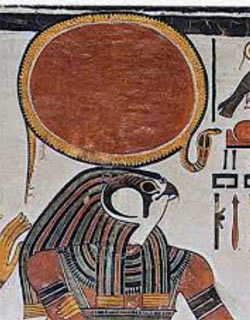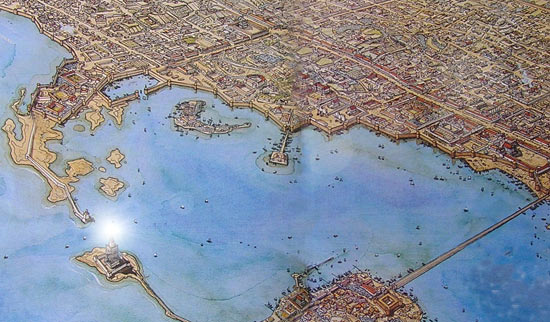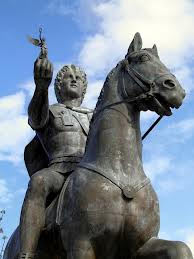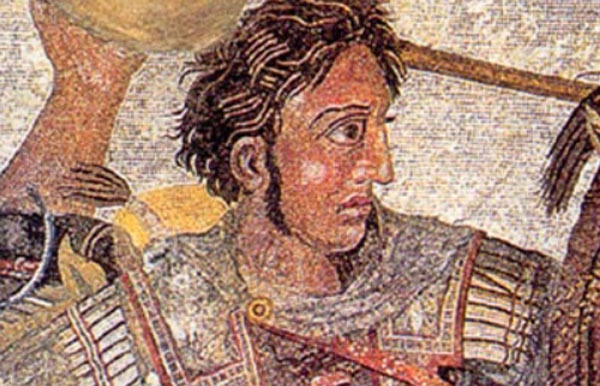The Canopus Way of Ancient Alexandria and the Birthday of Alexander the Great
In 332 BC after Alexander the Great defeated the Persian army of Darius III at Issus in Syria, he entered triumphantly with his army into Egypt. The twenty-four year old Macedonian king was hailed by the Egyptians as a liberator --some even going as far as claiming he was the returning god-pharaoh, son of the Sungod. The Egyptian priests knew that since childhood Alexander had entertained the belief that his true ‘father’ was Amun-Re, the solar god of Egypt, and whom the Greeks identified to Zeus-Ammon of the oracle at Siwa, an oasis deep in the Western Desert of Egypt. The belief that Zeus-Ammon of Siwa was his true ‘father’ was put into Alexander’s young mind by his highly strung and very mystical mother, Queen Olympias, once a high-priestess at the Oracle of Zeus at Dodona in Ipirus, the latter twinned with the oracle of Ammon at Siwa. Endowed with a deep mystical nature, Olympias believed she was destined to be the mother of a divine hero-son who, like the god Dionysos son of Zeus, would unite the world. When Olympias married Philip II of Macedonia in 357 BC, Egypt was under Persians occupation, the latter the traditional enemies of the Greeks. Legend has it that on her wedding night Olympias was visited by Zeus-Ammon who made her pregnant.
 Alexander’s dream, however, was not just to unite the world but also to create a universal city dedicated to knowledge and wisdom ---a great intellectual haven where scholars and philosophers from everywhere would share their knowledge and discoveries to benefit humanity. It is probable that the idea of a universal city of learning had been suggested to Alexander by the philosopher Aristotle who had tutored the young prince for many years. Aristotle had written the Politika, The Politics, in which he examines various systems of constitutions and the Ideal State, and the theme of which he surely discussed with his bright pupil, the young Alexander. Was Alexandria to be that ‘Ideal State’? For sure it became the universal center of learning for several centuries, as well as the place where its inhabitants called themselves citizens of the world i.e. Cosmopolitans. Here for a brief but enlightening moment in human history, all religions and races cohabited in relative peace. The term ‘cosmopolitan’ probably comes from Diogenes of Sinope (c. 415 BC) who, when asked to which state he belonged, answered: “I am a citizen of the World’ – Kosmopolites. Alexandria was probably the nearest thing to a ‘Cosmopolitan Utopia’ the world has ever known.
Alexander’s dream, however, was not just to unite the world but also to create a universal city dedicated to knowledge and wisdom ---a great intellectual haven where scholars and philosophers from everywhere would share their knowledge and discoveries to benefit humanity. It is probable that the idea of a universal city of learning had been suggested to Alexander by the philosopher Aristotle who had tutored the young prince for many years. Aristotle had written the Politika, The Politics, in which he examines various systems of constitutions and the Ideal State, and the theme of which he surely discussed with his bright pupil, the young Alexander. Was Alexandria to be that ‘Ideal State’? For sure it became the universal center of learning for several centuries, as well as the place where its inhabitants called themselves citizens of the world i.e. Cosmopolitans. Here for a brief but enlightening moment in human history, all religions and races cohabited in relative peace. The term ‘cosmopolitan’ probably comes from Diogenes of Sinope (c. 415 BC) who, when asked to which state he belonged, answered: “I am a citizen of the World’ – Kosmopolites. Alexandria was probably the nearest thing to a ‘Cosmopolitan Utopia’ the world has ever known.
Legend has it that the architect Dinoclates of Rhodes, under the direct guidance of Alexander himself, designed the city plan of Alexandria. The layout of the new city, however, reveals an Egyptian influence that can be termed ‘solar’, a sort of ‘City of the Sun’ to emulate the great solar cities in Egypt such as Heliopolis, the supreme ‘City of the Sun’ of the ancient world, and Thebes in Upper Egypt. There were two main arteries in ancient Alexandria: the Canopus Way and the Soma. The Canopus Way ran east-west and extended eastwards towards Canopus some twenty kilometers from Alexandria. The Soma ran north-south and intersected the Canopus Way to form a huge cross whose center was an open area known as the Agora. The Canopus Way was probably named after Kanopos, the legendary Homerian navigator who piloted the fleet of Menelaus in the Iliad. According to a Homeric myth, the town of Canopus (modern Abukir) in Egypt was founded by Menelaus, who named it after the pilot of his ship who died on its shore. Homer says that Menelaus built a shrine to his memory there, around which the town was later developed. A temple dedicated to Osiris was later built at Canopus by Ptolemy III. Herodotus, who wrote a century or so before the foundation of Alexandria, claimed that there was a temple dedicated to Heracles in that region. According to some Egyptologists, however, the name ‘Canopus’ derives from the fact that this road led to a temple where pilgrim deposited ‘canopic jars’ used in funerary rituals. Alexander is also well known to have claimed descent from Dionysos and Herakles, both of whom were associated with the Egyptian god Osiris by the historian and author Herodotus, whose books, The Histories, Alexander had diligently read several times. Thus at least since the time of Herodotus it was known that a temple dedicated to Herakles-Osiris at a town called Herakleon near modern day Abukir. The future Canopus Way axis, when extended towards the eastern horizon would have passed near Herakleion, something that Alexander would certainly have been made aware of. The town of Herakleion was submerged by a tsunami in antiquity, but has recently been rediscovered by French marine archaeologists.

At both ends of the Canopus Way were gates leading into the enclosed city area. The western gate was known as the ‘Gate of the Moon’ ( Selene) and the eastern gate the ‘Gate of the Sun’ ( Helios). Although historians have assumed that the layout plan of the city was based on the classical Greek grid system, the Egyptians had already used such grid layout --the solar-city Akhetaten (Horizon of Aten, the sun-disc) at Tell el Amarna is a good example-- long before the Greeks. Alexander, after all, had been proclaimed pharaoh of Egypt, a title that directly associated him to divine genealogy of the Sungod of Egypt. As such Alexander was to be seen as the reincarnation of Horus, the solar falcon god who was deemed reincarnated in the person of the pharaoh. Since time immemorial the birth of these Horus-kings was associated to the appearance at dawn of the star Sothis (Sirius). In late antiquity this occurred in late July (Julian) as observed from the latitude of Alexandria. In ancient Egypt many temples and even whole cities were often aligned to the rising sun to mark an important event. It would thus be totally in line with such a tradition that the Canopus Way of Alexandria would also have such a solar alignment to mark some important day related to Alexander the Great.
 When I lived in Alexandria I often witnessed the sunrise and sunset along the Shara’a Fuad, the modern tarmac road that today runs directly over the ancient Canopus Way –a fact confirmed by the Egyptian astronomer Mahmoud El Falaki Bey in the 1870s. El Falaki determined that there had been eleven main arteries running parallel along the width of the ancient city, and seven other artieries running parallel along the length of the city. The trial pits and trenches dug by El Falaki established that the Canopus Way was some 2300 meters long and that it was oriented to 24º north of east, within 30 arc minutes accuracy. Seen from the latitude of Alexandria, the sun rise points occurs between 28º southeast (winter solstice) and 28º northeast (summer solstice). The 1 st century chronicler Plutarch in his Life of Alexander writes that,
When I lived in Alexandria I often witnessed the sunrise and sunset along the Shara’a Fuad, the modern tarmac road that today runs directly over the ancient Canopus Way –a fact confirmed by the Egyptian astronomer Mahmoud El Falaki Bey in the 1870s. El Falaki determined that there had been eleven main arteries running parallel along the width of the ancient city, and seven other artieries running parallel along the length of the city. The trial pits and trenches dug by El Falaki established that the Canopus Way was some 2300 meters long and that it was oriented to 24º north of east, within 30 arc minutes accuracy. Seen from the latitude of Alexandria, the sun rise points occurs between 28º southeast (winter solstice) and 28º northeast (summer solstice). The 1 st century chronicler Plutarch in his Life of Alexander writes that,
Alexander was born the 6th of Hecatombaeon, which month the Macedonians call Lous, the same day that the temple of Diana at Ephesus was burnt…
Hecatombaeon was the first month in the Greek year. It was deemed to start on the first new moon following the summer solstice. It can be calculated that in 356 BCE, the year of Alexander’s birth, the new moon after the summer solstice fell on the 14 th July (Julian). Thus Alexander’s birth fell six days later on 20 th July. At this time the sun was in the sign of Leo, which may explain the leonine facial features and hair that ancient writers attributed to Alexander. Alexander or, more likely, his astronomers determined the alignment of the central axis of the city of Alexandria, later to be called the Canopus Way. It is therefore significant that this axis of this road is 24 degrees northeast, and thus targets the rising sun on the 20 th July, Alexander’s birthday. Also on that same day would have occurred the heliacal rising of Sirius, the Egyptian star whose rising marked the divine birth of the Horus-kings. All this strongly suggest, if not confirm, that the city of Alexandria was aligned to the sunrise on 20 th July to commemorate the birthday of its illustrious founder.
Postscript:
In 2004 I presented the hypothesis that the Canopus Way of Alexandria was oriented to the rising sun on the 20 th July Julian to mark the birthday of Alexander the Great in my book (co-authored with Graham Hancock) TALISMAN: Sacred Cities, Secret Faith (Penguin Books, 2004, pp. 204-209). Eight years later, in 2012, the astronomer Giulio Magli of Milano Politecnico and his colleague Dr. Luisa Ferro, an architect from the same polytechnic, have confirmed the validity if this theory (G. Magli and L. Ferro “The Astronomical Orientation of the Urban Plan of Alexandria”, Oxford Journal of Archaeology, Volume 31, Issue 4, November 2012, Pages: 381–389). The Oxford Journal of Archaeology is publishing in its May 2013 issue Volume 32.2, the following text by Magli and Ferro : “'In the paper ‘ The astronomical orientation of the urban plan of Alexandria’ we have applied rigorous archaeoastronomical and archaeological arguments to show that the Alexandria main axis was deliberately oriented to the sun rising on the day of Alexander's birth and to the king's star Regulus. After publication we have been informed that a similar solar orientation of the Alexandria main axis also related to Alexander's birth had already been proposed in 2004 in the book ‘Talisman:Sacred Cities, Secret Faith’ by Robert Bauval and Graham Hancock (Penguin Books, London 2004), whose priority in elaborating this idea is therefore here acknowledged.”




















